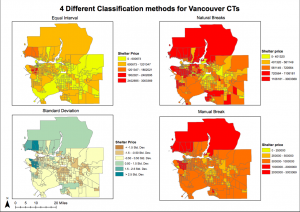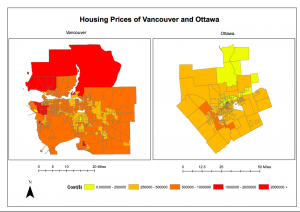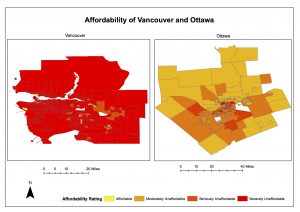As an illustration, here is VancouverCT’s housing price with 4 classification methods.

to view the PDF file of in full resolution, click this link: dataclass
There are 4 common classification schemes, and they are natural breaks, equal intervals, quantiles, and standard deviations. All four classification methods can be used to emphasize different features on a map depending on the purpose. I will be using example of housing price in Vancouver to illustrate. Natural breaks are created based on the natural categorization of the data that have relatively big differences in the data values. In the case of Vancouver housing price, the break is from ($) 0- 401320, 401320 -561149, 561149 – 720564 and so on. Since each data set will contain different ways of classifying itself, it is not useful for comparing between multiple maps with different underlying data. Equal intervals divides data into equal size ranges. In the Vancouver housing price case, it shows how many houses falls into a 5 ranges between 0 – 3003369 since each range have the same difference. Another method is quantile, with each data containing the same numbers of features. This shows between what range to what range will have the same number of housing. However this data can often be misleading as it doesn’t give valuable information even if each data range has the same number of features. Lastly, it is standard deviation. This is created by how much the value of interest differs from the mean value.
If I were a journalist, the classification method I will choose is standard deviation because I want to be as objective as possible when I am reporting the housing cost in Vancouver. Since standard deviation is how the price values is going to different from the mean housing price, this classification method is able to show how housing price differ from one part of Vancouver to another. I also want to include the overall picture of housing cost in all of Vancouver; thus standard deviation is best for big pictures unlike methods like equal interval, which is better for values in a familiar range. Housing prices around Vancouver fluctuates quite a bit.
However, if I were a real estate agent preparing for presentation for potential home buys near UBC, I would choose natural break classification. Since UBC is such a small region, differences within the small region need to be highlighted in order to target my client’s specific needs. Since housing price around UBC are going to be fairly similar, natural breaks is good at highlighting differences between each price range. There are definitely ethical implications for my choice. For example, if I choose manual interval where I set my own ranges of values as a journalist, my data might seem biased.
Since there is a substantial housing cost difference between Vancouver and Ottawa housing cost, I have created a map outlining housing cost of both cities.

to view the PDF file of in full resolution, click this link: housecostvo
While housing price is a good measurement of livability, affordability is a much more concrete measurement. Here is a affordability of housing comparison between Vancouver and Ottawa.

to view the PDF file of in full resolution, click this link: affordability
Affordability is measured by the ratio between housing price and household income. Housing affordability is a better indicator than housing cost alone. For example, there are two places, one with high housing price and one with low housing price, which one seems more attractive to be living in? At first glance, the area with low housing price seems more desirable for people with lower income, and the area with high housing price is completely unaffordable. However, if a person’s income is high, and can match the high housing price, then the area suddenly becomes affordable. Just based on housing price alone is not a good indicator of how “affordable” a place is. With the incorporation of income comparing to housing price, it is more accurate to judge if a place is affordable or not.
There are 4 categories of affordability rating. Affordable at 3.0 and under, moderately unaffordable 3.1 to 4.0, seriously unaffordable 4.1 to 5.0, and severely unaffordable 5.1 & Over. The 12th Annual Demographia International Housing Affordability Survey determines the affordability rating, and this type of rating is widely used by many. The rating category is an example of manual interval classification, which is appropriate in this case. With whole numbers for each range (3, 4, 5…), the categories are easily understood and interpreted by the public. Since it is a ratio between housing price and income, the number 3, for example, will mean that housing price is three times the income.
According to the livability of Vancouver, it is consider one of the most “livable” city in the world. Affordability is one factor that is considered when judging a city’s livability. There are many other factors such as air quality, water quality, and population density. Although those factors are important, in today’s society where income places a huge factor in people’s lives, affordability is a good indicator of a city’s livability. Vancouver is scoring really high on air quality and water quality and all the other factors; however, if a family can’t “afford” to live there because of its high housing price, it is still not livable for them. It is a current trend that many family is starting to move away to the rural areas of Vancouver because of high housing price, they moved because other areas are more affordable and “livable”. Thus a city’s livability is relative to a person’s income, thus affordability.